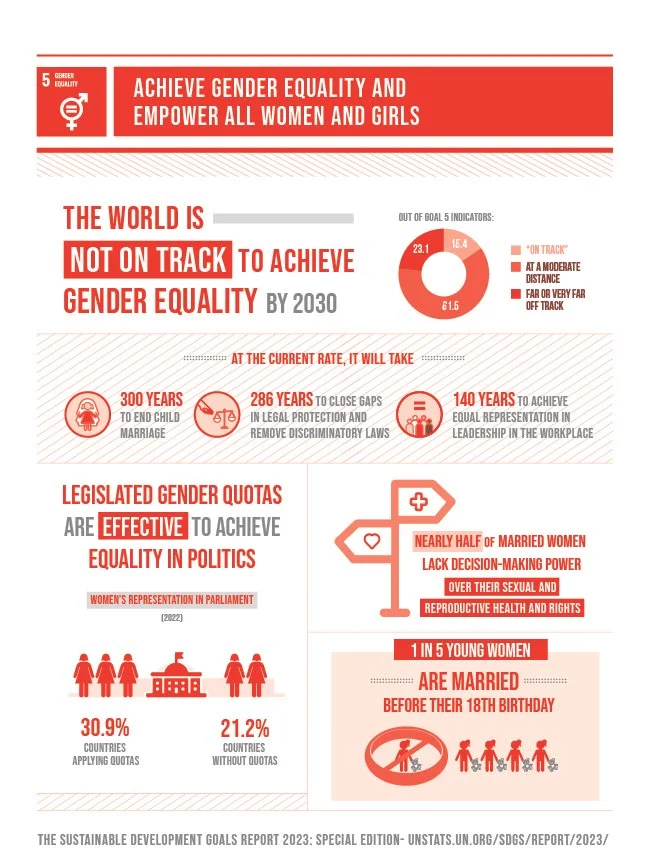Gender Equality
Gender equality is essential for a sustainable and equitable world. Sustainable Development Goal 5 (SDG 5) aims to “Achieve gender equality and empower all women and girls,” addressing systemic barriers and promoting equal opportunities. SDG 5 includes 9 targets and 14 indicators, covering areas such as discrimination (Target 5.1), violence (Target 5.2), harmful practices (Target 5.3), unpaid care work (Target 5.4), leadership opportunities (Target 5.5), and sexual and reproductive rights (Target 5.6). The means of implementation emphasize empowering women through policy, technology, and resource access (Targets 5.a, 5.b, 5.c).
NAV, a non-profit dedicated to uplifting at-risk youth, integrates SDG 5 into its mission by addressing the unique challenges faced by women and girls in underserved communities. Through its pillars of Nurture, Aid, and Vision, NAV empowers women and girls, creating pathways to equality and opportunity.
Understanding SDG 5 and Its Relevance to NAV’s Mission
SDG 5 underscores the importance of dismantling barriers that perpetuate inequality and ensuring women and girls have access to resources, education, and leadership opportunities. NAV’s commitment to supporting vulnerable youth, particularly young women and girls, directly contributes to these goals. By fostering environments where women can thrive, NAV not only advances gender equality but also strengthens communities.
How NAV Tackles SDG 5 Targets
1. Nurture: Supporting Women and Girls at the Foundation
NAV’s Nurture pillar focuses on creating safe and supportive environments for women and girls, addressing Targets 5.1, and 5.3.
Eliminating Discrimination (Target 5.1): NAV ensures that girls receive the same quantity and quality of supplies as boys, removing one of the most common barriers to girls’ continued schooling.
Ending Harmful Practices (Target 5.3): Keeping girls in class with free supplies lowers the economic pressure that can lead to early marriage; every extra year of schooling for a girl reduces her child-marriage risk and raises future earnings.
2. Aid: Providing Resources and Opportunities
NAV’s Aid initiatives ensure that women and girls have access to the resources they need to succeed, aligning with Targets 5.4.
Recognizing Unpaid Care Work (Target 5.4): By covering school-supply costs, we ease mothers’ financial and time burdens, freeing them to pursue income-generating work or further education of their own.
Measuring Impact: Key Indicators of Success
NAV evaluates its contributions to SDG 5 through measurable outcomes, including:
Reduction in Discrimination: Tracking instances of discriminatory practices addressed or eliminated in partner communities.
Support for Survivors: Monitoring the number of women and girls accessing NAV’s safe spaces and counseling services.
Leadership Roles: Assessing the percentage of women and girls participating in leadership training programs and taking on leadership positions.
Access to Resources: Measuring improvements in women’s access to economic resources, property, and technology.
Health Outcomes: Tracking access to reproductive health services and education among program participants.
Challenges and Opportunities
Challenges
Cultural Resistance: Deeply rooted cultural norms and traditions can impede progress toward gender equality.
Resource Constraints: Expanding programs to reach more women and girls often requires significant funding and partnerships.
Opportunities
Community Engagement: Collaborating with local leaders and influencers to promote gender equality within cultural contexts.
Global Advocacy: Participating in international forums and campaigns to amplify NAV’s impact and attract additional support.
Conclusion
NAV’s holistic approach to empowering women and girls education aligns seamlessly with SDG 5. Through its Nurture, Aid, and Vision pillars, NAV not only promotes gender equality but also paves the way for sustainable development.
Empowering women is not just a goal—it is a prerequisite for achieving a better future for all. NAV’s efforts to dismantle barriers and create opportunities for women and girls exemplify the transformative power of grassroots action in advancing global goals. Together, we can build a world where gender equality is not an aspiration but a reality.
